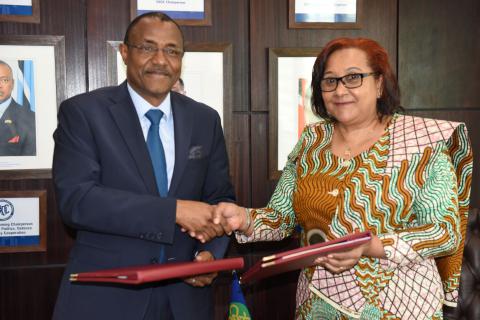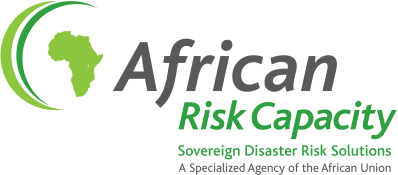
L-R: UN-ASG Mohamed Beavogui, Director-General, African Risk Capacity, and Dr. Stergomena L. Tax, Executive Secretary, Southern Africa Development Community (SADC) exchanging copies of the MoU at the SADC Secretariat, Gaborone, Botswana.
“The partnership will enable us to systematically work with SADC to better profile disaster risks facing the region, strengthen existing response capacities and contingency plans, and offer sovereign insurance options to enable rapid action when natural catastrophes occur” - ASG Mohamed Beavogui, DG, ARC
Gaborone, October 3, 2019 – The African Risk Capacity (ARC) and the Southern Africa Development Community (SADC) Secretariat today signed a Memorandum of Understanding (MoU) to strengthen resilience in the region through adoption of innovative frameworks on disaster risk management and financing.
The SADC region is prone to a myriad of climate and natural disaster risks including droughts, floods, tropical cyclones, storms, epidemics etc. These have had devastating impacts on the populations with negative consequences for livelihoods and economic growth.
The impact of these disasters has confirmed the need for strengthening existing preparedness and response mechanisms to match the changing nature of risks.
The agreement with SADC is intended to help put in place proactive and comprehensive measures to reduce the negative impact of disasters and other vulnerability drivers for better adaptation. It has been proven that early warning, contingency planning and risk financing through insurance can boost resilience, adaptation capacity and loss reduction.
“The partnership will enable us to systematically work with SADC to better profile disaster risks facing the region, strengthen existing response capacities and contingency plans, and offer sovereign insurance options to enable rapid action when natural catastrophes occur”, stated ASG Mohamed Beavogui, the Director-General of African Risk Capacity.
The SADC already has a Disaster Reduction Strategy which recognises the need for partnerships and cooperation to combat the wide range of disaster hazards that threaten lives and livelihood of its population.
The Executive Secretary, Southern Africa Development Community (SADC), Dr. Stergomena L. Tax, noted that the formalisation of partnership with ARC will place the region on a path to augmenting its existing response mechanism against drought and other climate risks. “We can now deliberately work together on issues of common interests and strengthening a comprehensive and integrated regional approach towards Disaster Risk Reduction and mitigation of all forms of hardships that occur as a result of increasing climate variability resulting in increasing incidences and severity of floods, droughts and cyclones in the SADC Region,” In addition the Executive Secretary also noted the importance of finalising, costing and rolling out a vibrant technical action plan to make the vision and dream of the two institutions a reality for the benefit of the SADC region’s peoples.
Under the Agreement, the parties will inter alia work jointly towards:
- Broadening Disaster Risk Financing and integration into disaster risk policy and frameworks in the SADC region;
- Exchanging of data and information on climate early warning;
- Piloting the integration of Africa RiskView toolinto National Vulnerability Assessment Committees;
- Improving existing regional and national flood modelling and forecasting tools; review of input data that is used in Africa Risk View, through sharing methodologies used for rainfall estimates and drought monitoring; and
- Disaster Risk Financing to build regional disaster risk management and financing capacities, mechanisms and tools for risk insurance facilities for addressing both humanitarian and infrastructure reconstruction and recovery needs.
The Southern African Development Community (SADC) is a Regional Economic Community (REC) established by the SADC Treaty of 1992, and is composed of 16 Member States. Much of the region’s population and economic growth is supported by Mining, Agriculture, Forestry, Tourism and Wildlife as well as Service Industries, which are all largely prone to climate related disasters.
The African Risk Capacity model is home-grown, innovative, cost-effective, and is proving that it can assist member-states to strengthen their capacities to better plan, prepare and respond to extreme weather events and natural disasters, thereby achieving the food security for their populations.
Since 2014, 32 policies have been signed by Member States with US$73million paid in premiums for a cumulative insurance coverage of US$553million for the protection of 55million vulnerable population in participating countries.
# # #
For more information, please visit: www.africanriskcapacity.org
PRESS CONTACT
Chinedu Moghalu chinedu.moghalu@africanriskcapacity.orgchinedu.moghalu@wfp.org





